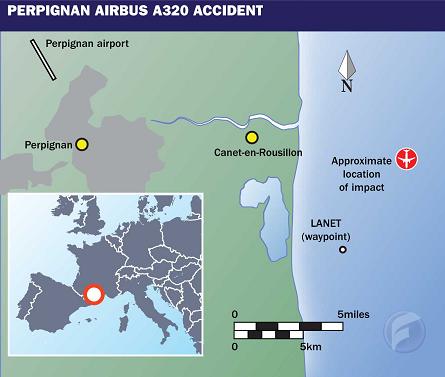The XL Airways Airbus A320 lost off France's Mediterranean south-west coast was the third of the type to crash offshore near an airport, but this aircraft was on a post-maintenance test sortie, not a scheduled revenue flight like the others (see below). All seven crew on board were killed.
A witness to the 27 November crash says the aircraft "really dived" into the water soon after it had intercepted the distance measuring equipment arc 11nm (20.3km) from Perpignan airport over the sea to the east.

Perpignan air traffic control had cleared the aircraft to LANET - a waypoint on the DME arc east-south-east of the airport - and to descend to 4,000ft (1,220m) for an instrument landing system approach for Runway 33. The pilot's acknowledgement of this instruction was the last contact. There was no emergency call. If this description is accurate, the aircraft would have been heading roughly south to intercept the ILS when it crashed.
The aircraft (D-AXLA) had been leased for two years to XL's German division by Air New Zealand's Freedom Air, and it had been at Perpignan to undergo maintenance at EAS Industries before being returned to its owner. The flight, which had reportedly lasted at least 1h before the crash, was a post-maintenance check flight from which the aircraft was due to return to Perpignan.
Airbus says the aircraft had accumulated 7,000 flight hours over 2,800 cycles. Meteorological data from Perpignan airport at the time of the accident - just before 17:00 local time - shows visibility as good, wind light, with high overcast.
Within 24h the French navy had positioned a minesweeper with divers to the site to recover the flight data and voice recorders and pass them on to the French accident investigation agency BEA
Twice since 2000 an A320 has crashed into the sea just offshore of an airport, but under very different circumstances: both the others were flying at night with no external visual reference and had to carry out go-arounds involving 180° climbing turns.
Both reports said the crews became disorientated and failed to recover from extreme attitudes in time to avoid hitting the sea. The first, in August 2000, involved a Gulf Air A320 at Bahrain, and the second was an Armavia A320 at Sochi.
Whatever went wrong at Perpignan, the crew had good external visual references. Also, statistically, non-revenue flights, including post-maintenance test flights or crew-only positioning flights, have a far higher accident rate than scheduled passenger flights.
Source: Flight International
















